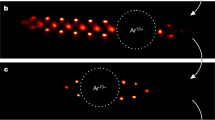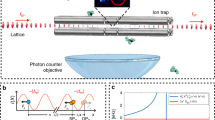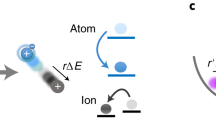Abstract
Precision laser spectroscopy1 of cold and trapped molecular ions is a powerful tool in fundamental physics—used, for example, in determining fundamental constants2, testing for their possible variation in the laboratory3,4, and searching for a possible electric dipole moment of the electron5. However, the absence of cycling transitions in molecules poses a challenge for direct laser cooling of the ions6, and for controlling7,8,9,10,11 and detecting their quantum states. Previously used state-detection techniques based on photodissociation12 or chemical reactions13 are destructive and therefore inefficient, restricting the achievable resolution in laser spectroscopy. Here, we experimentally demonstrate non-destructive detection of the quantum state of a single trapped molecular ion through its strong Coulomb coupling to a well controlled, co-trapped atomic ion. An algorithm based on a state-dependent optical dipole force14 changes the internal state of the atom according to the internal state of the molecule. We show that individual quantum states in the molecular ion can be distinguished by the strength of their coupling to the optical dipole force. We also observe quantum jumps (induced by black-body radiation) between rotational states of a single molecular ion. Using the detuning dependence of the state-detection signal, we implement a variant of quantum logic spectroscopy15,16 of a molecular resonance. Our state-detection technique is relevant to a wide range of molecular ions, and could be applied to state-controlled quantum chemistry17 and to spectroscopic investigations of molecules that serve as probes for interstellar clouds18,19.
This is a preview of subscription content, access via your institution
Access options
Subscribe to this journal
Receive 51 print issues and online access
$199.00 per year
only $3.90 per issue
Buy this article
- Purchase on Springer Link
- Instant access to full article PDF
Prices may be subject to local taxes which are calculated during checkout




Similar content being viewed by others
References
Germann, M., Tong, X. & Willitsch, S. Observation of electric-dipole-forbidden infrared transitions in cold molecular ions. Nature Phys. 10, 820–824 (2014)
Koelemeij, J., Roth, B., Wicht, A., Ernsting, I. & Schiller, S. Vibrational spectroscopy of HD+ with 2-ppb accuracy. Phys. Rev. Lett. 98, 173002 (2007)
Schiller, S. & Korobov, V. Tests of time independence of the electron and nuclear masses with ultracold molecules. Phys. Rev. A 71, 032505 (2005)
Flambaum, V. & Kozlov, M. Enhanced sensitivity to the time variation of the fine-structure constant and mp/me in diatomic molecules. Phys. Rev. Lett. 99, 150801 (2007)
Loh, H. et al. Precision spectroscopy of polarized molecules in an ion trap. Science 342, 1220–1222 (2013)
Shuman, E. S., Barry, J. F. & DeMille, D. Laser cooling of a diatomic molecule. Nature 467, 820–823 (2010)
Rellergert, W. G. et al. Evidence for sympathetic vibrational cooling of translationally cold molecules. Nature 495, 490–494 (2013)
Schneider, T., Roth, B., Duncker, H., Ernsting, I. & Schiller, S. All-optical preparation of molecular ions in the rovibrational ground state. Nature Phys. 6, 275–278 (2010)
Staanum, P. F., Højbjerre, K., Skyt, P. S., Hansen, A. K. & Drewsen, M. Rotational laser cooling of vibrationally and translationally cold molecular ions. Nature Phys. 6, 271–274 (2010)
Lien, C.-Y. et al. Broadband optical cooling of molecular rotors from room temperature to the ground state. Nature Commun. 5, 4783 (2014)
Hansen, A. K. et al. Efficient rotational cooling of Coulomb-crystallized molecular ions by a helium buffer gas. Nature 508, 76–79 (2014)
Højbjerre, K., Hansen, A. K., Skyt, P. S., Staanum, P. F. & Drewsen, M. Rotational state resolved photodissociation spectroscopy of translationally and vibrationally cold MgH+ ions: toward rotational cooling of molecular ions. New J. Phys. 11, 055026 (2009)
Tong, X., Winney, A. & Willitsch, S. Sympathetic cooling of molecular ions in selected rotational and vibrational states produced by threshold photoionization. Phys. Rev. Lett. 105, 143001 (2010)
Leibfried, D. et al. Experimental demonstration of a robust, high-fidelity geometric two ion-qubit phase gate. Nature 422, 412–415 (2003)
Schmidt, P. O. et al. Spectroscopy using quantum logic. Science 309, 749–752 (2005)
Wan, Y. et al. Precision spectroscopy by photon-recoil signal amplification. Nature Commun. 5, 4096 (2014)
Ratschbacher, L., Zipkes, C., Sias, C. & Köhl, M. Controlling chemical reactions of a single particle. Nature Phys. 8, 649–652 (2012)
Brünken, S. et al. H2D+ observations give an age of at least one million years for a cloud core forming Sun-like stars. Nature 516, 219–221 (2014)
Campbell, E. K., Holz, M., Gerlich, D. & Maier, J. P. Laboratory confirmation of as the carrier of two diffuse interstellar bands. Nature 523, 322–323 (2015)
Cirac, J. I. & Zoller, P. Quantum computations with cold trapped ions. Phys. Rev. Lett. 74, 4091 (1995)
Schmidt-Kaler, F. et al. Realization of the Cirac-Zoller controlled-NOT quantum gate. Nature 422, 408–411 (2003)
Nie, S. & Emory, S. R. Probing single molecules and single nanoparticles by surface-enhanced Raman scattering. Science 275, 1102–1106 (1997)
Schmidt, P. O. et al. in Proceedings of Non-Neutral Plasma Physics VI, Workshop on Non-Neutral Plasmas, Vol. 862 (eds Drewsen, M., Uggerhøj, U. & Knudsen, H. ) 305–312 (Aarhus, 2006)
Vogelius, I. S., Madsen, L. B. & Drewsen, M. Probabilistic state preparation of a single molecular ion by projection measurement. J. Phys. At. Mol. Opt. Phys. 39, S1259–S1265 (2006)
Hume, D. B. et al. Trapped-ion state detection through coherent motion. Phys. Rev. Lett. 107, 243902 (2011)
Balfour, W. J. Rotational analysis of the A1Σ+ → X1Σ+ and B1Π → X1Σ+ systems of 24MgH+, 25MgH+, and 26MgH+. Can. J. Phys. 50, 1082–1091 (1972)
Wan, Y., Gebert, F., Wolf, F. & Schmidt, P. O. Efficient sympathetic motional-ground-state cooling of a molecular ion. Phys. Rev. A 91, 043425 (2015)
Leibfried, D. Quantum state preparation and control of single molecular ions. New J. Phys. 14, 023029 (2012)
Ding, S. & Matsukevich, D. N. Quantum logic for the control and manipulation of molecular ions using a frequency comb. New J. Phys. 14, 023028 (2012)
Schiller, S., Bakalov, D. & Korobov, V. I. Simplest molecules as candidates for precise optical clocks. Phys. Rev. Lett. 113, 023004 (2014)
Hemmerling, B. et al. A single laser system for ground state cooling of 25Mg+. Appl. Phys. B 104, 583590 (2011)
Ozeri, R. et al. Hyperfine coherence in the presence of spontaneous photon scattering. Phys. Rev. Lett. 95, 030403 (2005)
Gebert, F. et al. Damage-free single-mode transmission of deep-UV light in hollow-core PCF. Opt. Express 22, 15388–15396 (2014)
James, D. F. V. Quantum dynamics of cold trapped ions with application to quantum computation. Appl. Phys. B 66, 181–190 (1998)
Hemmerling, B., Gebert, F., Wan, Y. & Schmidt, P. O. A novel, robust quantum detection scheme. New J. Phys. 14, 023043 (2012)
Aymar, M., Guérout, R., Sahlaoui, M. & Dulieu, O. Electronic structure of the magnesium hydride molecular ion. J. Phys. At. Mol. Opt. Phys. 42, 154025 (2009)
Hansson, A. & Watson, J. K. A comment on Hönl-London factors. J. Mol. Spectrosc. 233, 169–173 (2005)
Bergmann, K. & Shore, B. W. Coherent Population Transfer, Ch. 9 (eds Dai, H.-L. & Field, R. W. ) 367 (World Scientific, 1995)
Acknowledgements
We acknowledge the support of the Deutsche Forschungsgemeinschaft through QUEST and grant SCHM2678/3-1. This work was financially supported by the State of Lower-Saxony, Hannover, Germany. Y.W. acknowledges support from the Braunschweig International Graduate School of Metrology. We thank E. Tiemann, H. Knöckel, O. Dulieu and I.D. Leroux for discussions; M. Drewsen and O. Dulieu for the transition-matrix elements for 24MgH+; and E. Tiemann, B. Hemmerling, and I.D. Leroux for reading the manuscript.
Author information
Authors and Affiliations
Contributions
P.O.S. conceived and supervised the experiment. F.W. developed the read-out algorithm. F.W., J.C.H. and C.S. carried out the measurements. Y.W. performed the simulations and calculated the lattice coupling strength. F.W. and P.O.S. wrote the main part of the manuscript. Y.W. and F.G. built essential parts of the experiment. All authors discussed the results and contributed to the manuscript.
Corresponding author
Ethics declarations
Competing interests
The authors declare no competing financial interests.
Extended data figures and tables
Extended Data Figure 1 Single trajectory from a Monte Carlo simulation of molecular dynamics.
a, The ion initially prepared in the rotational ground state is transferred to higher rotational states because of coupling to black-body radiation at 300 K. b, The probability of finding the ion in a certain rotational state in the simulation (red bars) follows a thermal distribution. The blue bars are calculated values from a master equation approach. The deviation between the red and blue bars results from the finite time interval of the Monte Carlo wavefunction simulation. c, The dwell time decreases for higher rotational states.
Extended Data Figure 2 Rabi flopping between motional states.
Implementation of the sequence shown in Fig. 2 for ΩMgH = 0. The duration of the applied optical lattice is varied to induce Rabi flopping between the motional qubit states |↓〉m and |↑〉m. The error bars show the 95% confidence interval of the photon-distribution fit35. The red dashed line shows a fit to a damped oscillation.
Extended Data Figure 3 Full experimental sequence.
a, Circuit description of the sequence. i, A BSB π-pulse initializes the atom in the state |↑〉Mg and the motional state in the qubit state |↓〉m. ii, The ODF rotates the motional qubit controlled by the internal state of the molecule (see Fig. 2). iii, A second BSB π-pulse maps the motional state (which contains the information about the molecule’s internal state) to the atomic qubit. iv, The atomic qubit’s state is read out by state-dependent fluorescence. b, Pictorial representation of the laser couplings in a simplified level scheme.
Source data
Rights and permissions
About this article
Cite this article
Wolf, F., Wan, Y., Heip, J. et al. Non-destructive state detection for quantum logic spectroscopy of molecular ions. Nature 530, 457–460 (2016). https://doi.org/10.1038/nature16513
Received:
Accepted:
Published:
Issue Date:
DOI: https://doi.org/10.1038/nature16513
This article is cited by
-
Non-KAM classical chaos topology for electrons in superlattice minibands determines the inter-well quantum transition rates
Scientific Reports (2024)
-
Laser spectroscopy of a rovibrational transition in the molecular hydrogen ion \({\mathbf{H}}_{\mathbf{2}}^{\mathbf{+}}\)
Nature Physics (2024)
-
Single molecule infrared spectroscopy in the gas phase
Nature (2023)
-
Quantum logic detection of collisions between single atom–ion pairs
Nature Physics (2022)
-
Collision detection with logic
Nature Physics (2022)
Comments
By submitting a comment you agree to abide by our Terms and Community Guidelines. If you find something abusive or that does not comply with our terms or guidelines please flag it as inappropriate.



